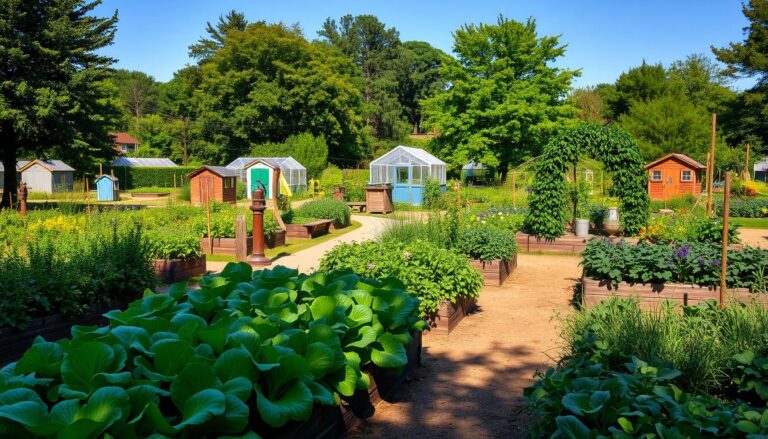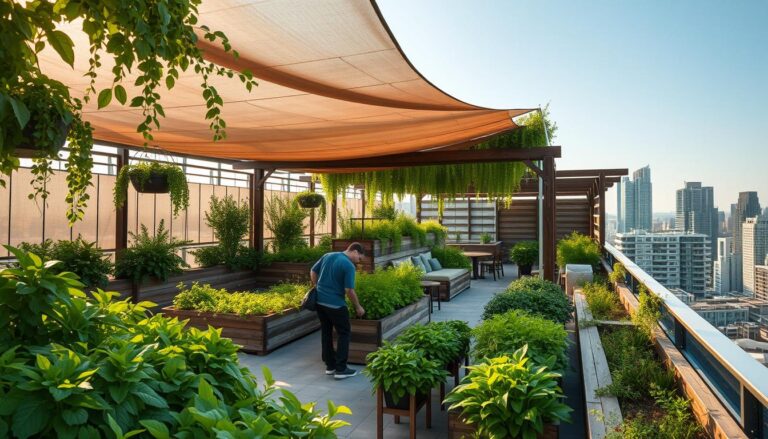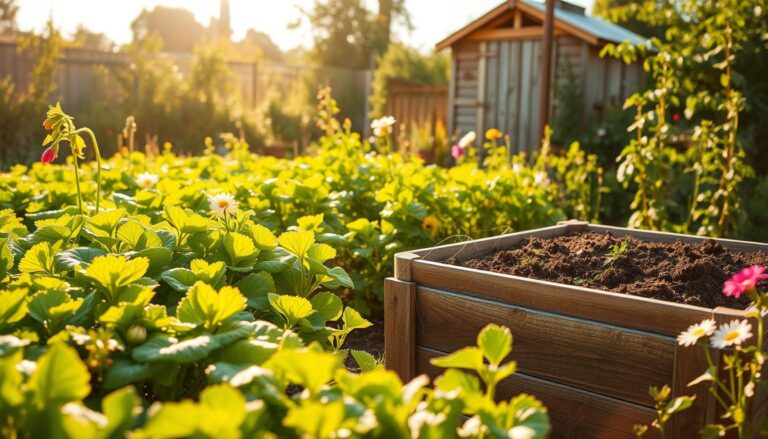Growing your own organic garden in small areas is not only possible but also very rewarding. With the rise of urban gardening, people are finding new ways to grow their own food, even in tiny spaces.
By using organic gardening for small spaces methods, you can enjoy fresh food right at home. It also improves the air and makes your home look better. It’s a chance to connect with nature and control what you eat.
Starting urban gardening can change your life, turning any small spot into a green paradise. You don’t need a big yard to grow your own organic garden. Just a balcony, patio, or windowsill is enough to begin.
The Joy and Benefits of Growing Your Own Food
Growing your own food is more than just picking fresh veggies. It’s about boosting your health and mood. By using container gardening or sustainable gardening, you can enjoy many benefits.
Health Advantages of Homegrown Produce
Homegrown food is packed with nutrients and lacks harmful chemicals. Eating organic can make you healthier overall.
| Benefit | Description |
|---|---|
| Increased Nutrient Intake | Homegrown produce is often richer in nutrients. |
| Reduced Chemical Exposure | Organic gardening avoids the use of harmful chemicals. |
Mental Wellbeing and Connection to Nature
Gardening is good for your mind, lowering stress and connecting you with nature. This can make you feel better mentally and improve your overall wellbeing.
Understanding Organic Gardening for Small Spaces
Organic gardening in small areas means making big changes for tiny spaces. This is key for apartment gardening and other small gardens.
Principles of Organic Growing Methods
Organic gardening works with nature, not against it. It uses natural stuff and ways to keep soil healthy and pests away.
- Using compost to enrich the soil
- Avoiding synthetic fertilizers and pesticides
- Encouraging beneficial insects and microorganisms
Adapting Organic Practices to Limited Areas
When space is tight, gardening needs to be smart. No-dig methods and natural fertilizers are great for small gardens.
No-Dig Methods for Containers
No-dig gardening keeps soil healthy by not messing with it. It’s perfect for container gardens.
Natural Fertilizers for Small Gardens
For tiny gardens, natural fertilizers like compost tea or worm casting are best. They give nutrients without harming the environment.
By using these small space gardening tips, you can have a lush organic garden in even the smallest spots.
Assessing and Maximizing Your Available Space
Starting an organic garden is easy, even with little space. You can garden on a balcony, windowsill, or in a community garden. Every urban area has a spot for gardening.
Balconies, Patios and Rooftops
Balconies, patios, and rooftops are great for gardening. They get lots of sunlight and can hold many plants. Think about the sunlight direction and amount for the best plants.
Tips for balcony gardening: Pick light containers, make sure they’re secure, and choose plants that handle wind well.
Windowsills and Indoor Growing Areas
Indoor spaces are perfect for gardening too. Windowsills are great for herbs and small plants needing sunlight. For less light, grow lights can help.
- Choose plants that do well indoors, like leafy greens and herbs.
- Use containers that fit your space and have good drainage.
Community Garden Opportunities
Community gardens are a good option if you don’t have space. They let people garden together, sharing knowledge and tools.
Sharing Resources and Knowledge
Community gardens are more than growing plants. They build a community. Members share seeds, tools, and know-how, helping all gardeners.
| Gardening Space | Ideal Plants | Considerations |
|---|---|---|
| Balconies/Patios | Vegetables, Herbs, Flowers | Sunlight, Wind Resistance |
| Windowsills | Herbs, Leafy Greens | Light Exposure, Temperature |
| Community Gardens | Varied, Depending on Plot | Plot Size, Shared Resources |
Essential Tools and Materials for Urban Gardening
Urban gardeners need the right tools and materials to succeed. In small spaces, picking the right equipment is key. It helps you grow more and work more efficiently.
Space-Efficient Containers and Planters
Choosing the right containers is crucial for container gardening. Look for planters that are at least 5-7 gallons. This gives most vegetables and herbs enough room to grow.
Consider using self-watering planters or those with built-in water reservoirs. They help you water less often.
- Plastic and terracotta pots are popular choices.
- Vertical planters can maximize space.
- Recycled materials like old boots or wooden crates can be creatively repurposed.
Quality Soil Mixes and Amendments
The quality of your soil mix is key to plant health. Use a high-quality potting mix made for containers. It keeps moisture but also drains excess water.
Adding organic amendments like compost or worm casting can boost soil fertility.
Compact Watering Systems
Efficient watering is vital in urban gardening. Drip irrigation or soaker hoses are great. They deliver water directly to the roots, cutting down on evaporation and runoff.
Self-Watering Options for Busy Gardeners
For those with busy schedules, self-watering systems are a lifesaver. These systems have a water reservoir. They supply plants with moisture as needed, so you don’t have to water as often.
Best Plants for Small Space Organic Gardens
Organic gardening in small spaces needs careful plant picking. The right plants can grow well in tight spots. They give a lot of harvest and make your garden more sustainable.
Herbs That Thrive in Containers
Herbs are great for small gardens because they grow small and are useful in cooking. Basil, mint, and cilantro are favorites that grow well in pots. They need little care and can be picked often, which is good for sustainable gardening.
Compact and Dwarf Vegetable Varieties
Many veggies are made for small spaces, growing small or dwarf. Tomatoes, peppers, and cucumbers have small versions for pots. These plants are not only good for eating but also make your garden look nice.
Fruits and Berries for Limited Spaces
Fruits and berries can also grow in small gardens. Strawberries, blueberries, and dwarf apple trees are great for small areas. They can grow in pots or vertical gardens, saving space and giving tasty fruits.
Vertical Fruiting Options
For even more space-saving, try vertical gardening with fruiting plants. Use trellises or wall systems to grow melons, grapes, or kiwi. This method saves space and makes your garden look interesting.
By picking the right plants and using vertical gardening, you can make a thriving small space organic garden. This way, you get fresh food and help the environment.
Vertical Gardening: Growing Up Instead of Out
Urban dwellers can now grow lush gardens in tight spaces. Vertical gardening uses walls and trellises to grow plants. This way, you can have a garden without taking up too much floor space.
Wall-Mounted Systems and Living Walls
Wall-mounted systems bring greenery to unused wall areas. They can be simple planters or complex living walls with plants and irrigation. Living walls not only look great but also clean the air and make rooms feel better.
Trellises and Support Structures
Trellises help plants like peas and beans grow upwards. You can make them from wood, metal, or recycled materials. This is a green and affordable way to grow your garden up.
Hanging Gardens and Suspended Planters
Hanging gardens and planters use vertical space well. They can hang from ceilings or balconies. They add beauty and increase growing space indoors or outdoors.
DIY Vertical Garden Projects
DIY fans can make their own vertical gardens. You can use old pallets or create trellis systems. It’s a fun way to make a unique and thriving garden.
| Vertical Gardening Method | Description | Best For |
|---|---|---|
| Wall-Mounted Systems | Planters or living walls attached directly to walls. | Herbs, succulents, and flowering plants. |
| Trellises | Support structures for climbing plants. | Peas, beans, and climbing flowers. |
| Hanging Gardens | Suspended planters or gardens. | Ferns, ivy, and flowering plants. |
Using vertical gardening in small spaces can lead to a fruitful harvest. It also makes your garden look beautiful, even in tight spots.
Indoor Gardening Techniques for Year-Round Harvests
Indoor gardening lets you grow organic fruits, veggies, and herbs all year. It’s perfect for small spaces. You can enjoy a fresh harvest, no matter the season.
Light Requirements and Solutions
Light is key for indoor gardening. Plants need enough light to grow. If your space is dim, LED grow lights are a great solution. They’re energy-saving and meet plant needs.
Each plant has its own light needs. Leafy greens like lettuce do well in dim light. But, plants that produce fruit, like tomatoes, need more light.
Managing Humidity and Temperature
Indoor gardens need a controlled environment. Plants like daytime temps between 65-75°F (18-24°C). At night, they prefer 55-65°F (13-18°C). Humidity should be 40-60%.
Use a humidifier or thermometer to keep these conditions. This ensures your plants thrive.
Edible Houseplants and Microgreens
Edible houseplants, like herbs and microgreens, are ideal for indoor gardens. Microgreens are young, packed with nutrients. They grow fast and need little space.
Kitchen Herb Gardens
Indoor kitchen herb gardens are handy. Pick a container that fits your kitchen. Choose herbs you often use, like basil or parsley.
| Plant | Light Requirement | Temperature Range |
|---|---|---|
| Basil | Bright, indirect light | 65-75°F (18-24°C) |
| Lettuce | Low to moderate light | 60-70°F (15-21°C) |
| Tomatoes | High light | 65-75°F (18-24°C) |
Conclusion: Nurturing Your Garden and Yourself
Organic gardening in small spaces is great for our health and the planet. You can make a lush garden even with little room. This is thanks to smart planning, the right tools, and picking the best plants.
Gardening is more than just growing plants. It helps us connect with nature and lowers stress. You can start a garden on a balcony, patio, or even a windowsill. This way, you can enjoy fresh, healthy food right in the city.
Organic gardening in small spaces leads to a better life. It’s not just about the garden. It’s about living healthier and more sustainably. So, start gardening today. Get your hands dirty and watch your garden and life grow.
FAQ
What are the best plants for a small organic garden?
How can I maximize my balcony space for gardening?
What is the best way to fertilize my organic garden?
How can I maintain a healthy indoor garden?
Can I grow a kitchen herb garden indoors?
What are some tips for starting a community garden?
How can I adapt organic gardening practices to small spaces?
What are the benefits of using self-watering containers?

Sortemdia nasceu com o propósito de trazer alegria e oportunidades para todos por meio de sorteios gratuitos de prêmios incríveis. O site tem como missão oferecer experiências acessíveis, divertidas e justas para quem deseja concorrer a produtos, serviços e brindes sem pagar nada por isso. Acreditamos que a sorte pode bater à porta de qualquer pessoa — e no Sortemdia, ela pode chegar com apenas um clique.



